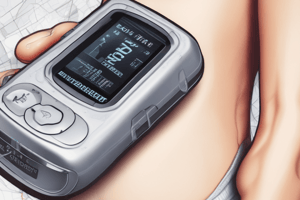Podcast
Questions and Answers
What is the nozzle pressure for a 1 3/8" Chief nozzle?
What is the nozzle pressure for a 1 3/8" Chief nozzle?
- 60 PSI
- 50 PSI (correct)
- 100 PSI
- 80 PSI
What is the flow rate for a 1" SB nozzle?
What is the flow rate for a 1" SB nozzle?
- 200 GPM
- 175 GPM (correct)
- 210 GPM
- 150 GPM
What is the friction loss for 1.75" Combat Ready hose?
What is the friction loss for 1.75" Combat Ready hose?
- 35 PSI
- 25 PSI
- 20 PSI (correct)
- 30 PSI
What is the NP for the given examples?
What is the NP for the given examples?
What is the elevation loss per floor?
What is the elevation loss per floor?
What is the flow rate for a 200' of 1.78" Combat Sniper hose with a 7/8" tip?
What is the flow rate for a 200' of 1.78" Combat Sniper hose with a 7/8" tip?
What is the friction loss formula?
What is the friction loss formula?
What is the standpipe pressure?
What is the standpipe pressure?
What is the PDP for the example on page 18?
What is the PDP for the example on page 18?
What is the flow rate for a 300' of 2.25" hose with a 1 1/8" tip?
What is the flow rate for a 300' of 2.25" hose with a 1 1/8" tip?
Flashcards are hidden until you start studying
Study Notes
Pump Chart Introduction
- The Pump Chart is a tool used by Engineers to calculate pump pressures and flows
- It is essential to review the Pump Chart periodically to maintain proficiency in pump operations
Pump Discharge Pressure (PDP) Formula
- The PDP formula is used to calculate the total pressure required to pump water through a hose
- The formula takes into account nozzle pressure (NP), friction loss (FL), elevation (ELEV), and appliance pressure (APPL)
Friction Loss (FL) Calculation
- Friction loss is calculated using the hose diameter and the flow rate of the nozzle
- The friction loss is then multiplied by the length of the hose (in hundreds of feet)
Elevation (ELEV) Calculation
- Elevation is calculated based on the number of floors above or below the pump
- The elevation loss or gain is then added or subtracted from the total PDP
Appliance Pressure (APPL)
- Appliance pressure is the pressure required to operate a specific appliance, such as a deck gun or aerial waterway
- The appliance pressure is added to the total PDP
Nozzle Pressure (NP)
- Nozzle pressure is the pressure required to produce a specific flow rate from a nozzle
- The nozzle pressure is affected by the nozzle size and the flow rate
Crosslay and Extended Hose Operations
- Crosslay operations involve using multiple hoses to increase flow rates
- Extended hose operations involve using longer hoses to reach remote areas
- The Pump Chart can be used to calculate the PDP for both crosslay and extended hose operations
Trash Line Operations
- The trash line consist of 100’ of 1.75” hose with an Elkhart Chief nozzle that delivers 175 GPM
- The trash line is used for overhaul and vehicle fires
- The Chief Nozzle will NOT be used for structural firefighting
Denver Bundles and High-Rise Operations
- Denver Bundles consist of 150’ of 2.25” hose with a 1” tip that delivers 210 GPM
- High-Rise Operations involve using longer hoses to reach higher floors
- The Pump Chart can be used to calculate the PDP for high-rise operations
Examples of Pump Chart Calculations
- Multiple examples of pump chart calculations are provided, including single crosslay, two crosslays, 1.78” extended from 2.5” bulk bed, Blitz Line, and Trash Line operations
- Each example includes the calculation of nozzle pressure, friction loss, elevation, appliance pressure, and pump discharge pressure.
Studying That Suits You
Use AI to generate personalized quizzes and flashcards to suit your learning preferences.





